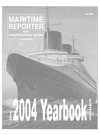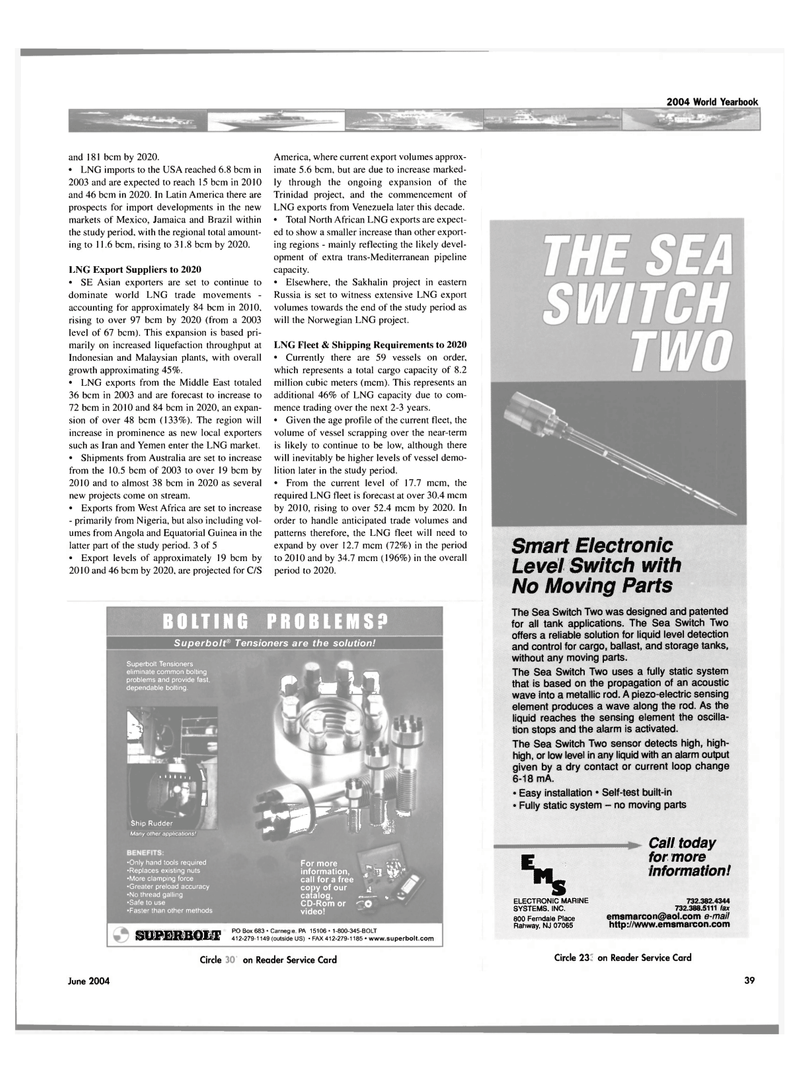
Page 39: of Maritime Reporter Magazine (June 2004)
Annual World Yearbook
Read this page in Pdf, Flash or Html5 edition of June 2004 Maritime Reporter Magazine
2004 World Yearbook and 181 bcm by 2020. • LNG imports to the USA reached 6.8 bcm in 2003 and are expected to reach 15 bcm in 2010 and 46 bcm in 2020. In Latin America there are prospects for import developments in the new markets of Mexico, Jamaica and Brazil within the study period, with the regional total amount- ing to 11.6 bcm, rising to 31.8 bcm by 2020.
LNG Export Suppliers to 2020 • SE Asian exporters are set to continue to dominate world LNG trade movements - accounting for approximately 84 bcm in 2010, rising to over 97 bcm by 2020 (from a 2003 level of 67 bcm). This expansion is based pri- marily on increased liquefaction throughput at
Indonesian and Malaysian plants, with overall growth approximating 45%. • LNG exports from the Middle East totaled 36 bcm in 2003 and are forecast to increase to 72 bcm in 2010 and 84 bcm in 2020, an expan- sion of over 48 bcm (133%). The region will increase in prominence as new local exporters such as Iran and Yemen enter the LNG market. • Shipments from Australia are set to increase from the 10.5 bcm of 2003 to over 19 bcm by 2010 and to almost 38 bcm in 2020 as several new projects come on stream. • Exports from West Africa are set to increase - primarily from Nigeria, but also including vol- umes from Angola and Equatorial Guinea in the latter part of the study period. 3 of 5 • Export levels of approximately 19 bcm by 2010 and 46 bcm by 2020, are projected for C/S
America, where current export volumes approx- imate 5.6 bcm, but are due to increase marked- ly through the ongoing expansion of the
Trinidad project, and the commencement of
LNG exports from Venezuela later this decade. • Total North African LNG exports are expect- ed to show a smaller increase than other export- ing regions - mainly reflecting the likely devel- opment of extra trans-Mediterranean pipeline capacity. • Elsewhere, the Sakhalin project in eastern
Russia is set to witness extensive LNG export volumes towards the end of the study period as will the Norwegian LNG project.
LNG Fleet & Shipping Requirements to 2020 • Currently there are 59 vessels on order, which represents a total cargo capacity of 8.2 million cubic meters (mem). This represents an additional 46% of LNG capacity due to com- mence trading over the next 2-3 years. • Given the age profile of the current fleet, the volume of vessel scrapping over the near-term is likely to continue to be low, although there will inevitably be higher levels of vessel demo- lition later in the study period. • From the current level of 17.7 mem, the required LNG fleet is forecast at over 30.4 mem by 2010, rising to over 52.4 mem by 2020. In order to handle anticipated trade volumes and patterns therefore, the LNG fleet will need to expand by over 12.7 mem (72% ) in the period to 2010 and by 34.7 mem (196%) in the overall period to 2020.
BOLTING PROBLEMS?
Superbolt® Tensioners are the solution!
Superbolt Tensioners eliminate common bolting problems and provide fast, dependable bolting. b . • i I i , , \
I
Ship Rudder
Many other applications! •Only hand tools required •Replaces existing nuts •More clamping force •Greater preload accuracy •No thread galling •Safe to use •Faster than other methods
SUPE R BOL T if^- km LI rtmi Sr
For more „ • \ \\ information, Wfei" call for a free " copy of our 4 catalog, *
CD-Rom or ^ O video!
PO Box 683 • Carnegie PA 15106 • 1-800-345-BOLT 412-279-1149 (outside US) • FAX 412-279-1185 • www.superbolt.com
Smart Electronic
Level Switch with
No Moving Parts
The Sea Switch Two was designed and patented for all tank applications. The Sea Switch Two offers a reliable solution for liquid level detection and control for cargo, ballast, and storage tanks, without any moving parts.
The Sea Switch Two uses a fully static system that is based on the propagation of an acoustic wave into a metallic rod. A piezo-electric sensing element produces a wave along the rod. As the liquid reaches the sensing element the oscilla- tion stops and the alarm is activated.
The Sea Switch Two sensor detects high, high- high, or low level in any liquid with an alarm output given by a dry contact or current loop change 6-18 mA. • Easy installation • Self-test built-in • Fully static system - no moving parts s
ELECTRONIC MARINE
SYSTEMS. INC. 800 Ferndale Place
Rahway, NJ 07065
Call today for more information! 732.382.4344 732.388.5111 lax [email protected] e-mail http://www.emsmarcon.com
Circle 226 on Reader Service Card Circle 235 on Reader Service Card
June 2004 39

 38
38

 40
40
